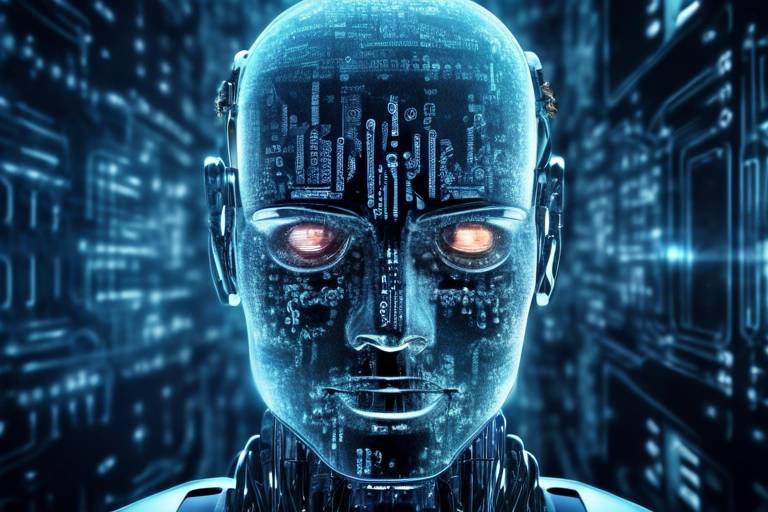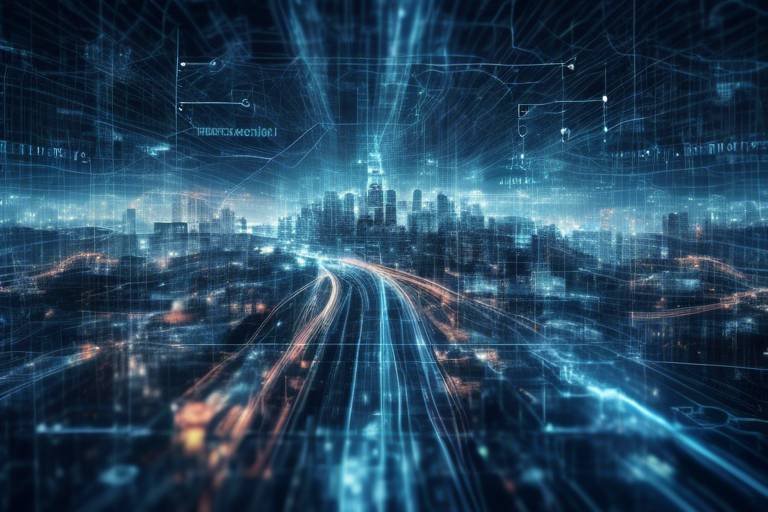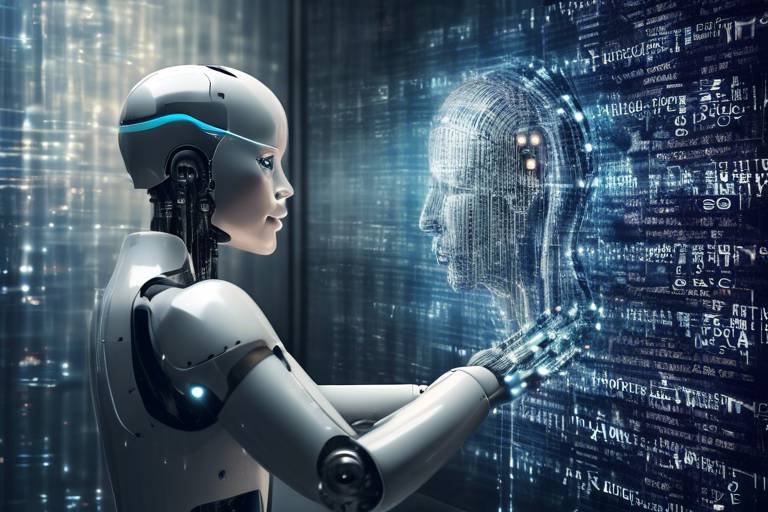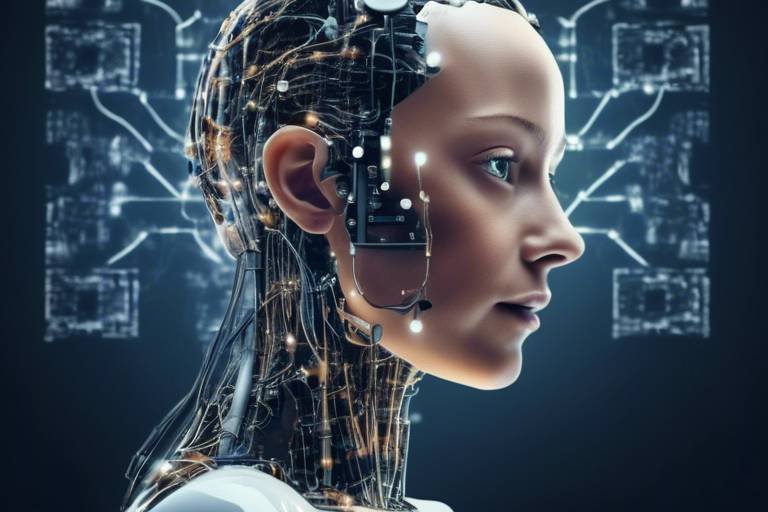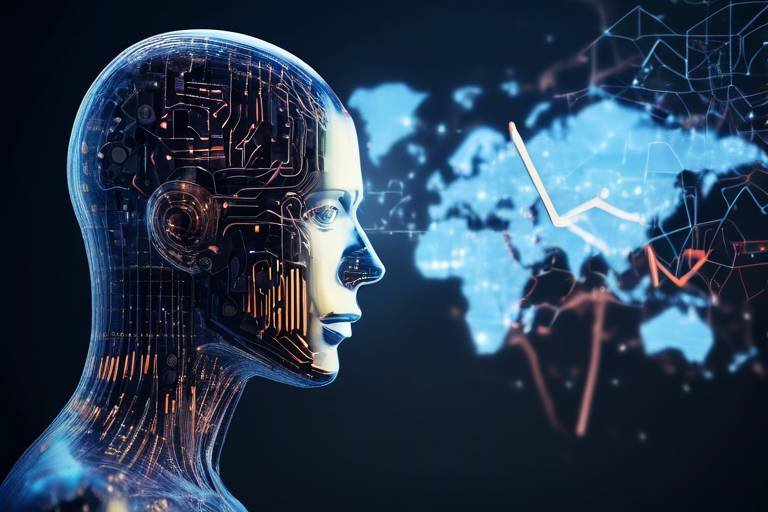AI Capabilities in Future of Cybersecurity
The landscape of cybersecurity is constantly evolving, and at the forefront of this transformation is artificial intelligence (AI). As we venture deeper into the digital age, the combination of AI and cybersecurity is not just a trend; it’s becoming a necessity. Imagine AI as a vigilant guardian, tirelessly monitoring and defending our virtual environments from an ever-growing array of cyber threats. This article delves into how AI is reshaping the future of cybersecurity, making it more robust, efficient, and responsive to the challenges that lie ahead.
In a world where cyber attacks are becoming increasingly sophisticated, relying solely on traditional security measures is akin to using a paper shield against a barrage of arrows. AI introduces a new layer of defense that goes beyond human capabilities. By leveraging machine learning, predictive analytics, and behavioral biometrics, organizations can stay one step ahead of cybercriminals. The integration of AI into cybersecurity frameworks not only enhances threat detection but also streamlines incident response, making it a game changer for businesses and individuals alike.
As we explore the numerous ways AI is enhancing cybersecurity, it’s essential to understand its fundamental role. AI technologies are not just tools; they are integral components of a comprehensive security strategy. They analyze vast amounts of data in real-time, identify patterns, and predict potential threats before they materialize. This proactive approach to security is crucial in a landscape where every second counts. With AI, organizations can not only react to incidents but also anticipate them, leading to a more resilient security posture.
Furthermore, the future of cybersecurity powered by AI promises to be more user-friendly. As security measures evolve, they must also cater to the user experience. AI-driven authentication processes, such as behavioral biometrics and enhanced multi-factor authentication, ensure that security doesn’t come at the expense of convenience. Users can enjoy seamless access to their accounts while knowing that their sensitive information is protected by advanced technology.
However, the integration of AI in cybersecurity is not without its challenges. As we embrace this technology, we must also navigate the ethical considerations and potential pitfalls that come with it. Issues surrounding data privacy and algorithmic bias need to be addressed to ensure that AI enhances cybersecurity for everyone, rather than inadvertently creating new vulnerabilities.
In conclusion, the capabilities of AI in the future of cybersecurity are vast and transformative. Organizations that harness the power of AI will not only improve their defenses against cyber threats but will also foster a culture of security awareness and resilience. As we continue to innovate and adapt, AI stands as a beacon of hope in the ongoing battle against cybercrime.
- How does AI improve cybersecurity? AI enhances cybersecurity by providing advanced threat detection, automating incident response, and improving user authentication processes.
- What are some challenges of using AI in cybersecurity? The main challenges include data privacy concerns and the potential for algorithmic bias, which can affect the fairness of security measures.
- Can AI predict future cyber threats? Yes, AI utilizes predictive analytics to analyze historical data and forecast potential cyber threats, allowing organizations to strengthen their defenses proactively.
- What is behavioral biometrics? Behavioral biometrics analyze user behavior patterns to create a unique profile for each user, adding an extra layer of security to authentication processes.

Understanding AI in Cybersecurity
Artificial Intelligence (AI) has emerged as a revolutionary force in the realm of cybersecurity, fundamentally altering how organizations protect their digital assets. At its core, AI refers to the simulation of human intelligence in machines, enabling them to learn, reason, and make decisions. This capability is particularly crucial in cybersecurity, where the landscape is constantly evolving with new threats and vulnerabilities. By integrating AI technologies into security frameworks, organizations can enhance their ability to detect, respond to, and mitigate cyber threats.
To grasp the significance of AI in cybersecurity, it’s essential to understand how these technologies function. AI systems utilize algorithms and data to identify patterns and anomalies, which are pivotal for recognizing potential security breaches. For instance, machine learning, a subset of AI, enables systems to learn from historical data and improve their performance over time. This means that the more data these systems analyze, the better they become at predicting and responding to threats. Imagine having a security guard who not only watches for intruders but also learns from past incidents to anticipate future attacks—that’s the power of AI in cybersecurity.
Moreover, AI's ability to process vast amounts of data in real-time allows organizations to stay ahead of cybercriminals. Traditional security measures often struggle to keep pace with the speed and sophistication of modern attacks. In contrast, AI-driven solutions can analyze network traffic, user behavior, and other relevant data points almost instantaneously. This rapid analysis is crucial for timely threat detection, enabling organizations to respond before a minor incident escalates into a full-blown security breach.
As we delve deeper into the world of AI in cybersecurity, it's important to recognize the various components that contribute to its effectiveness. Some key elements include:
- Data Analysis: AI systems analyze large volumes of data to identify trends and anomalies that may indicate a security threat.
- Automation: AI automates routine security tasks, allowing human analysts to focus on more complex issues.
- Continuous Learning: AI models continuously learn from new data, ensuring they remain effective against emerging threats.
In summary, understanding AI in cybersecurity is about recognizing its transformative potential. By leveraging AI technologies, organizations can not only enhance their security measures but also create a proactive defense strategy that adapts to the ever-changing threat landscape. This proactive approach is essential in today's digital world, where cyber threats are becoming increasingly sophisticated and frequent.
- What is AI in cybersecurity? AI in cybersecurity refers to the use of artificial intelligence technologies to detect, analyze, and respond to cyber threats effectively.
- How does AI improve threat detection? AI enhances threat detection by analyzing large datasets in real-time to identify patterns and anomalies that may indicate security breaches.
- What are the main benefits of using AI in cybersecurity? The main benefits include faster threat detection, improved response times, automation of routine tasks, and continuous learning from new data.

Threat Detection and Response
In today's digital world, where cyber threats lurk around every corner, the need for robust threat detection and response mechanisms has never been more critical. With the rise of sophisticated attacks, organizations are turning to AI-driven systems to revolutionize the way they monitor and respond to potential breaches. Imagine having a vigilant security guard who never sleeps; that’s what AI brings to the table in the realm of cybersecurity. By leveraging advanced technologies, businesses can now identify vulnerabilities and respond to incidents with remarkable speed and efficiency.
AI technologies are not just about reacting to threats; they are about predicting them. This predictive capability stems from the use of machine learning algorithms, which analyze vast amounts of data to uncover patterns that might indicate a potential cyber attack. For instance, these algorithms can sift through countless logs and network traffic data, identifying anomalies that would be nearly impossible for a human analyst to spot in real-time. This level of analysis not only enhances the accuracy of threat detection but also significantly reduces the time it takes to respond to incidents.
At the heart of AI's effectiveness in cybersecurity are machine learning algorithms. These algorithms function like an ever-evolving brain, learning from new data and experiences to improve their predictions over time. By processing historical data, they can forecast potential threats and help organizations stay one step ahead of cybercriminals. For example, a machine learning model can analyze patterns from previous attacks and recognize similar behaviors in current data, alerting security teams to investigate further. This proactive approach not only mitigates risks but also strengthens the overall security posture of an organization.
One of the most powerful applications of AI in threat detection is anomaly detection. This technique involves monitoring network traffic and user behavior to identify any unusual patterns that may signal a breach. Think of it as a smoke detector for your network; it alerts you to potential dangers before they turn into raging fires. For example, if a user typically logs in from a specific location and suddenly attempts to access the system from a different country, the anomaly detection system can flag this behavior for further investigation. By catching these anomalies early, organizations can prevent serious security incidents from escalating.
In addition to detecting threats, AI also plays a crucial role in automated incident response. Imagine a scenario where a cyber attack is detected, and the system can automatically initiate a response without human intervention. This capability is game-changing, as it drastically reduces the response time and minimizes the potential damage from attacks. Automated systems can isolate affected networks, block malicious traffic, and even initiate recovery processes—all within seconds. This rapid response not only protects sensitive information but also helps maintain the trust of customers and stakeholders.
Beyond real-time detection and response, AI is also instrumental in predictive analytics. By analyzing historical data, AI can forecast potential cyber threats, enabling organizations to bolster their defenses proactively. It’s like having a crystal ball that reveals the future of cybersecurity threats. For instance, if an organization notices a trend of increased phishing attacks during a specific time of year, they can ramp up their security measures in anticipation. This foresight allows businesses to stay ahead of attackers and fortify their defenses before threats materialize.
In conclusion, the integration of AI in threat detection and response is transforming the cybersecurity landscape. With its ability to analyze vast amounts of data, identify anomalies, and automate responses, AI empowers organizations to defend against cyber threats more effectively than ever before. As we continue to embrace digital transformation, the role of AI in cybersecurity will only grow, shaping a safer online environment for everyone.
- What is AI's role in cybersecurity? AI enhances threat detection, automates responses, and helps predict potential cyber threats by analyzing data.
- How do machine learning algorithms improve cybersecurity? They learn from historical data to identify patterns and predict future threats, allowing for quicker responses.
- What is anomaly detection? It's a technique used to identify unusual patterns in network traffic that could indicate a security breach.
- Can AI completely replace human cybersecurity teams? While AI significantly enhances security measures, human oversight is still crucial for complex decision-making and ethical considerations.

Machine Learning Algorithms
Machine learning algorithms are at the forefront of transforming how organizations approach cybersecurity. These algorithms are designed to learn from data, identify patterns, and make predictions, which is crucial in a landscape where cyber threats are constantly evolving. Imagine having a vigilant guard that not only watches for intruders but also learns their tactics over time—this is essentially what machine learning does for cybersecurity. By analyzing vast amounts of data, these algorithms can detect anomalies and flag potential threats much faster than traditional methods.
One of the key advantages of machine learning in cybersecurity is its ability to process and analyze data at an unprecedented scale. With cyberattacks becoming more sophisticated, relying solely on human oversight can lead to missed threats. Machine learning algorithms can sift through terabytes of data, identifying trends and irregularities that might indicate a breach. For instance, if a user typically logs into their account from a specific location but suddenly appears to access it from a different country, the algorithm can flag this behavior as suspicious. This capability is crucial in preventing unauthorized access and protecting sensitive information.
Another significant aspect of machine learning algorithms is their adaptability. As new threats emerge, these algorithms can adjust and improve their detection capabilities without requiring extensive reprogramming. This self-improving nature means that organizations can stay one step ahead of cybercriminals. For example, if a new ransomware variant is discovered, machine learning systems can analyze the characteristics of this variant and update their detection protocols accordingly. This dynamic response is essential for maintaining robust cybersecurity defenses.
To illustrate the impact of machine learning algorithms in cybersecurity, consider the following table that outlines some common types of algorithms used and their specific applications:
| Algorithm Type | Application |
|---|---|
| Decision Trees | Used for classifying data and identifying potential threats based on historical patterns. |
| Neural Networks | Emulates human brain functioning to detect complex patterns in data, ideal for identifying sophisticated attacks. |
| Support Vector Machines | Effective in classifying data into different categories, helping in spam detection and malware classification. |
| Clustering Algorithms | Groups similar data points together, useful in identifying unusual behavior in user activity. |
In conclusion, machine learning algorithms are revolutionizing the cybersecurity landscape by providing organizations with the tools to detect and respond to threats more efficiently. By leveraging the power of data analysis and pattern recognition, these algorithms not only enhance security measures but also empower organizations to proactively defend against potential cyber threats. As we continue to advance into a more digital future, the role of machine learning in cybersecurity will only become more critical.
Frequently Asked Questions
- What are machine learning algorithms?
Machine learning algorithms are computational models that learn from data to identify patterns and make predictions, particularly useful in cybersecurity for detecting threats. - How do machine learning algorithms improve cybersecurity?
They analyze vast amounts of data to identify unusual patterns, enabling faster detection of potential threats and automated responses. - Can machine learning algorithms adapt to new threats?
Yes, these algorithms can learn and adapt over time, allowing them to update their detection capabilities as new types of cyber threats emerge.

Anomaly Detection
Anomaly detection is like having a vigilant watchdog that never sleeps, constantly monitoring your network for anything that seems out of the ordinary. In the vast world of cybersecurity, where threats can emerge from the most unexpected corners, identifying unusual patterns in network traffic is crucial. This is where AI steps in, leveraging its advanced algorithms to sift through massive amounts of data and pinpoint anomalies that could indicate a potential breach. Imagine a bustling city with millions of cars on the road; if one vehicle suddenly speeds in the wrong direction, it stands out like a sore thumb. Similarly, AI-powered anomaly detection systems can highlight deviations from established norms, enabling security teams to act swiftly before minor issues balloon into significant threats.
The effectiveness of anomaly detection hinges on its ability to learn and adapt. By employing machine learning techniques, these systems can continuously refine their understanding of what constitutes "normal" behavior for a given network. This dynamic learning process means that as the network evolves, so too does the detection capability, allowing organizations to stay one step ahead of cybercriminals. For instance, if a user typically logs in from a specific location and suddenly attempts access from a different country, the system can flag this as suspicious. By doing so, it not only enhances security but also reduces the likelihood of false positives, which can drain resources and lead to alarm fatigue among security personnel.
Moreover, the integration of anomaly detection into a broader cybersecurity strategy can significantly bolster an organization’s defense mechanisms. When anomalies are detected early, organizations can implement immediate countermeasures, such as isolating affected systems or launching deeper investigations to ascertain the nature of the threat. This proactive approach is essential in today’s fast-paced digital landscape, where the speed of response can mean the difference between a minor incident and a full-blown data breach.
In essence, anomaly detection powered by AI serves as a critical component of modern cybersecurity frameworks. It transforms the way organizations monitor their networks, shifting from a reactive posture to a proactive one. As cyber threats continue to evolve, embracing sophisticated anomaly detection techniques will be paramount in safeguarding sensitive data and maintaining the integrity of digital infrastructures.
- What is anomaly detection in cybersecurity?
Anomaly detection refers to the process of identifying unusual patterns or behaviors in network traffic that may indicate a potential security threat or breach.
- How does AI enhance anomaly detection?
AI enhances anomaly detection by utilizing machine learning algorithms that can learn from historical data, adapt to new patterns, and identify deviations from normal behavior more effectively.
- Why is early detection of anomalies important?
Early detection is crucial because it allows organizations to respond quickly to potential threats, minimizing damage and preventing small issues from escalating into significant security incidents.
- Can anomaly detection reduce false positives?
Yes, by continuously learning and adapting to normal user behavior, AI-powered anomaly detection systems can reduce the number of false positives, allowing security teams to focus on genuine threats.

Automated Incident Response
In today's fast-paced digital landscape, the speed at which cyber threats evolve is staggering. This is where systems come into play, acting as the frontline defenders in the battle against cybercrime. Imagine having a team of cyber warriors that never sleeps; these systems work tirelessly to identify, assess, and neutralize threats before they can wreak havoc on your organization. By leveraging artificial intelligence, these automated systems can analyze vast amounts of data in real time, making them quicker and more efficient than any human team could ever hope to be.
One of the most significant advantages of automated incident response is its ability to drastically reduce response times. Traditional methods often involve lengthy processes, requiring human intervention at every step. However, with AI-powered automation, organizations can respond to incidents in a matter of seconds. This rapid response not only minimizes potential damage but also helps maintain the integrity of critical systems. For instance, when a security breach is detected, automated systems can immediately isolate affected networks, block malicious traffic, and even initiate recovery protocols without waiting for human approval.
Furthermore, these systems are designed to learn and adapt over time. Using machine learning algorithms, they analyze previous incidents to improve their response strategies. This means that with every attack, the system becomes more adept at predicting and countering future threats. The process is akin to training a guard dog; the more experiences it has, the better it becomes at recognizing threats and responding appropriately.
However, while automation offers numerous benefits, it is essential to remember that it is not a silver bullet. Organizations must still maintain a balance between automated responses and human oversight to ensure that responses are appropriate and effective. In some cases, automated systems may misinterpret data, leading to false positives or negatives. Therefore, having a skilled cybersecurity team that can oversee and refine these automated processes is crucial.
To illustrate the effectiveness of automated incident response systems, consider the following table that highlights key features and benefits:
| Feature | Benefit |
|---|---|
| Real-time Monitoring | Immediate threat detection and response |
| Data Analysis | Informed decision-making based on historical data |
| Isolation Protocols | Prevention of spread during a security breach |
| Learning Algorithms | Continuous improvement in threat response strategies |
In conclusion, automated incident response systems are revolutionizing the way organizations handle cybersecurity threats. By combining speed, efficiency, and adaptability, these systems not only protect valuable assets but also provide peace of mind in an increasingly perilous digital world. As we continue to explore the capabilities of AI in cybersecurity, the importance of maintaining a human touch will remain paramount, ensuring that technology serves as a powerful ally in the fight against cybercrime.
- What is automated incident response?
Automated incident response refers to the use of AI and machine learning technologies to detect and respond to cybersecurity threats without human intervention, allowing for faster and more efficient threat management.
- How does automated incident response improve security?
By enabling real-time monitoring and rapid response to incidents, automated systems minimize potential damage and help organizations maintain the integrity of their systems.
- Can automated systems replace human cybersecurity teams?
While automated systems significantly enhance security measures, they should complement human oversight rather than replace it, as human expertise is crucial for interpreting complex data and making nuanced decisions.

AI for Predictive Analytics
In the ever-evolving landscape of cybersecurity, predictive analytics powered by artificial intelligence (AI) is becoming a game-changer. Imagine having a crystal ball that not only reveals potential threats but also allows organizations to fortify their defenses before an attack even occurs. This is precisely what AI-driven predictive analytics offers. By harnessing the power of vast amounts of historical data, AI systems can identify patterns and trends that human analysts might overlook. It's as if you had a seasoned detective on your team, piecing together clues from the past to prevent future crimes.
To understand how AI enhances predictive analytics, we must first recognize the significance of data. Organizations generate an enormous volume of data daily, from user behaviors to network traffic. AI algorithms sift through this data, identifying anomalies and potential risks. For instance, if a particular user typically logs in from one geographical location but suddenly accesses the system from a different country, AI can flag this behavior for further investigation. This proactive approach not only enhances security but also streamlines incident response processes, allowing teams to focus on genuine threats rather than false alarms.
Moreover, predictive analytics can utilize various data sources to improve threat forecasting. These can include:
- Historical attack data
- Real-time network traffic
- User behavior analytics
- Threat intelligence feeds
However, it's essential to note that while AI can significantly enhance predictive capabilities, it is not infallible. The effectiveness of predictive analytics relies heavily on the quality of the data fed into the system. Poor data quality can lead to inaccurate predictions and, consequently, misguided security strategies. Therefore, organizations must ensure they have robust data governance practices in place to maintain the integrity of their data.
In conclusion, AI for predictive analytics is not just a trend; it's a necessity in today's cybersecurity landscape. By leveraging historical data and advanced algorithms, organizations can anticipate threats and implement measures that safeguard their digital assets. As we move forward, the integration of AI in predictive analytics will likely become more sophisticated, offering even greater insights into potential vulnerabilities and enhancing overall security posture.
- What is predictive analytics in cybersecurity?
Predictive analytics in cybersecurity involves using AI and historical data to forecast potential threats and vulnerabilities, allowing organizations to strengthen their defenses proactively. - How does AI improve threat detection?
AI improves threat detection by analyzing vast amounts of data to identify patterns and anomalies that may indicate a security breach, enabling quicker response times. - What are the challenges of using AI in cybersecurity?
Challenges include data privacy concerns, algorithmic bias, and the need for high-quality data to ensure accurate predictions.

Enhancing User Authentication
In today's digital age, where data breaches and cyber threats are rampant, enhancing user authentication has become a top priority for organizations. The integration of artificial intelligence (AI) technologies into authentication processes is revolutionizing how we secure access to sensitive information. Traditional methods, such as passwords, are no longer sufficient to protect against sophisticated attacks. This is where AI steps in, providing innovative solutions that not only improve security but also enhance user experience.
One of the most exciting advancements in user authentication is the use of biometrics. Biometrics refers to the unique physical characteristics of individuals, such as fingerprints, facial recognition, and iris scans. AI algorithms analyze these biometric data points to ensure that only legitimate users gain access. This approach is not only more secure but also incredibly user-friendly, as it eliminates the need to remember complex passwords. Imagine simply looking at your device or touching a sensor to gain instant access—it's seamless and efficient!
Another significant development in enhancing user authentication is the use of behavioral analysis. AI systems can monitor user behavior patterns, such as typing speed, mouse movements, and navigation habits. By establishing a baseline of normal behavior, these systems can detect anomalies that may indicate unauthorized access attempts. For example, if a user typically logs in from a specific location at a certain time and suddenly tries to access their account from a different country at an unusual hour, the AI can flag this as suspicious activity. This proactive approach not only strengthens security but also minimizes the chances of false positives, which can frustrate legitimate users.
Moreover, the incorporation of multi-factor authentication (MFA) has been significantly enhanced by AI technologies. MFA requires users to provide two or more verification factors to gain access, adding an extra layer of security. AI can streamline this process by incorporating intelligent verification methods, such as sending a one-time password (OTP) via text or email, alongside biometric verification. This means that even if a password is compromised, unauthorized users would still face multiple barriers before gaining access to sensitive information.
As we look towards the future, the potential for AI to enhance user authentication continues to grow. Organizations are increasingly adopting these technologies to create a more secure and user-friendly environment. However, it is essential to remain vigilant about the ethical implications of using AI in this context. As we leverage these advanced technologies, we must ensure that they do not inadvertently lead to privacy violations or discrimination.
In conclusion, enhancing user authentication through AI technologies is not just about improving security; it's about creating a more seamless and efficient experience for users. By embracing innovations such as biometrics, behavioral analysis, and multi-factor authentication, organizations can significantly bolster their defenses against cyber threats while making access to sensitive information as convenient as possible.
- What is AI-enhanced user authentication?
AI-enhanced user authentication refers to the use of artificial intelligence technologies to improve the processes that verify a user's identity, making them more secure and user-friendly. - How does biometric authentication work?
Biometric authentication uses unique physical characteristics, such as fingerprints or facial recognition, analyzed by AI algorithms to confirm a user's identity. - What is behavioral analysis in user authentication?
Behavioral analysis monitors user behavior patterns and establishes a baseline to detect any anomalies that may indicate unauthorized access attempts. - Why is multi-factor authentication important?
Multi-factor authentication adds an extra layer of security by requiring users to provide multiple forms of verification, making it significantly harder for unauthorized users to gain access.

Behavioral Biometrics
In today's digital landscape, where cyber threats loom large, is emerging as a game-changing technology in the realm of cybersecurity. Unlike traditional biometrics that rely on physical traits like fingerprints or facial recognition, behavioral biometrics focuses on the unique patterns of user behavior. This includes how a person types, moves their mouse, or even how they hold their device. Imagine it as a digital fingerprint that evolves with the user, making it incredibly difficult for unauthorized individuals to replicate.
The beauty of behavioral biometrics lies in its ability to provide an additional layer of security without compromising user experience. For instance, when you log into your online banking account, the system doesn't just check your password; it also analyzes your typing speed, the pressure you apply on the keyboard, and the rhythm of your interactions. If something seems off—like a sudden change in typing speed or an unusual device being used—the system can trigger additional security measures. This proactive approach not only helps in preventing unauthorized access but also enhances the overall user experience by minimizing friction during the authentication process.
Moreover, behavioral biometrics can be seamlessly integrated into existing security frameworks, making it a versatile solution for organizations of all sizes. Here's a quick look at some of the key aspects of behavioral biometrics:
- Continuous Authentication: Unlike traditional methods that authenticate users only at the point of entry, behavioral biometrics allows for ongoing verification throughout a session. This means that if a user's behavior suddenly deviates from the norm during a session, the system can automatically log them out or prompt for additional verification.
- Fraud Detection: By continuously analyzing user behavior, organizations can effectively identify and mitigate potential fraud attempts. If a fraudster tries to access an account, their behavior will likely differ significantly from that of the legitimate user, raising red flags for the security system.
- Reduced False Positives: Traditional security measures often lead to false positives, where legitimate users are flagged as threats. Behavioral biometrics significantly reduces this risk by focusing on the nuanced patterns of individual users, thereby enhancing the accuracy of threat detection.
In essence, behavioral biometrics not only fortifies security measures but also adapts to the unique characteristics of each user. It's like having a personal bodyguard for your digital identity—always watching, always learning, and always ready to defend against potential threats. As organizations continue to embrace this innovative technology, we can expect a significant reduction in unauthorized access and an overall enhancement of digital security.
As we continue to explore the vast applications of AI in cybersecurity, behavioral biometrics stands out as a beacon of hope, merging security with user-friendliness. With this technology, the future of digital security looks not only promising but also incredibly secure.
- What is behavioral biometrics? Behavioral biometrics is a security measure that analyzes individual user behavior patterns to authenticate identity, enhancing security beyond traditional methods.
- How does behavioral biometrics improve security? By continuously monitoring user behavior, it can detect anomalies that may indicate unauthorized access, providing real-time security responses.
- Is behavioral biometrics user-friendly? Yes, it enhances user experience by allowing seamless authentication without interrupting the user’s workflow.
- Can behavioral biometrics be used alongside other security measures? Absolutely! It can complement existing security protocols, such as passwords and multi-factor authentication, for a more robust security framework.

Multi-Factor Authentication
In today's digital landscape, where cyber threats loom large, Multi-Factor Authentication (MFA) has emerged as a crucial line of defense against unauthorized access. MFA adds an additional layer of security by requiring users to provide multiple forms of verification before they can access sensitive information or systems. This approach significantly reduces the risk of breaches that can occur with just a username and password combination, which is often not enough to deter determined attackers.
Imagine trying to enter a high-security vault. Just having the key isn't sufficient; you also need a fingerprint scan and a code sent to your phone. This is essentially how MFA operates. By combining something you know (like a password) with something you have (like a smartphone) and something you are (like a fingerprint), MFA creates a robust barrier against intrusions.
AI plays a vital role in enhancing MFA systems. It intelligently analyzes user behavior to determine the legitimacy of access attempts. For instance, if a user typically logs in from New York at 9 AM, but suddenly tries to access their account from a different country at midnight, AI can flag this as suspicious activity. This dynamic approach not only strengthens security but also improves user experience by minimizing false positives.
Furthermore, MFA can incorporate a variety of authentication methods, including:
- SMS or Email Codes: A one-time code sent to the user's registered phone number or email address.
- Authenticator Apps: Applications like Google Authenticator or Authy generate time-sensitive codes for login.
- Biometric Verification: Fingerprints, facial recognition, or voice recognition provide a secure and user-friendly authentication method.
As organizations increasingly adopt MFA, they must also consider the user experience. If the authentication process becomes too cumbersome, users may be tempted to bypass security measures or resort to insecure practices. Therefore, striking a balance between security and usability is essential. The integration of AI helps achieve this balance by streamlining the authentication process while maintaining a high level of security.
In conclusion, Multi-Factor Authentication is not just a trend; it's a necessary evolution in cybersecurity. As cyber threats continue to grow in sophistication, leveraging AI to enhance MFA will be vital in protecting sensitive data and ensuring that only legitimate users gain access. Organizations that invest in robust MFA systems will not only safeguard their assets but also build trust with their users, proving that they take security seriously.
- What is Multi-Factor Authentication?
MFA is a security measure that requires users to provide two or more verification factors to gain access to a resource, making it harder for unauthorized users to access sensitive information.
- How does AI enhance Multi-Factor Authentication?
AI analyzes user behavior patterns to identify suspicious login attempts, thereby improving the overall security and user experience of MFA systems.
- What are common methods used in MFA?
Common methods include SMS or email codes, authenticator apps, and biometric verification such as fingerprints or facial recognition.
- Is MFA difficult to implement?
While implementing MFA may require some initial setup and user education, the long-term benefits of enhanced security far outweigh the challenges.

Challenges and Ethical Considerations
As the integration of artificial intelligence (AI) into cybersecurity grows, it brings with it a slew of challenges and ethical considerations that cannot be overlooked. While AI promises to enhance security measures significantly, it also raises questions that demand our attention. For instance, how do we balance the need for robust security with the fundamental right to privacy? The very nature of AI involves collecting and analyzing vast amounts of data, which can include sensitive personal information. This creates a delicate dance between protecting users and respecting their privacy rights.
One of the most pressing issues is the potential for data privacy concerns. When AI systems gather data to improve threat detection or user authentication, they may inadvertently expose sensitive information. It's not just about what data is collected, but also how it is stored and used. Organizations must ensure that they have stringent data protection measures in place, as any breach or misuse of this data could lead to significant repercussions. Imagine a scenario where a company using AI for security inadvertently leaks customer data due to poor handling practices; the fallout could be catastrophic, damaging trust and reputation.
Moreover, we must consider the risk of algorithmic bias. AI systems learn from historical data, and if that data reflects existing biases, the algorithms can perpetuate and even amplify these biases. For example, if an AI system is trained on data that disproportionately represents certain demographics, it may perform poorly for underrepresented groups. This could lead to unequal security measures, where some individuals face more stringent scrutiny than others based solely on their background or behavior patterns. This raises profound questions about fairness and accountability in cybersecurity practices.
To navigate these challenges, organizations should adopt a proactive approach by implementing ethical frameworks that guide their use of AI in cybersecurity. This includes:
- Conducting regular audits of AI systems to identify and mitigate biases.
- Establishing transparent data handling practices that prioritize user privacy.
- Engaging with diverse stakeholders to ensure that the AI systems are fair and equitable.
As we move forward, it is essential for the cybersecurity community to engage in open discussions about these challenges. By doing so, we can foster a more inclusive and fair approach to AI in cybersecurity that not only protects users but also respects their rights. The journey ahead may be complex, but with careful consideration and ethical foresight, we can harness the power of AI without compromising our values.
- What are the main challenges of using AI in cybersecurity?
The main challenges include data privacy concerns, algorithmic bias, and the need for ethical frameworks to guide AI use.
- How can organizations ensure data privacy when using AI?
Organizations can ensure data privacy by implementing robust data protection measures, conducting audits, and being transparent about data handling practices.
- What is algorithmic bias, and why is it a concern?
Algorithmic bias occurs when AI systems reflect historical biases present in the data they are trained on, leading to unequal treatment of different groups.

Data Privacy Concerns
As we dive deeper into the integration of artificial intelligence in cybersecurity, the conversation inevitably shifts towards . While AI offers remarkable capabilities in enhancing security measures, it also raises significant questions about how personal data is collected, stored, and utilized. Imagine a world where every click, every keystroke, and every online interaction is meticulously analyzed by AI algorithms. Sounds like a sci-fi thriller, right? But this is the reality we are stepping into.
The primary concern revolves around the collection of personal data. To effectively combat cyber threats, AI systems require vast amounts of data to learn and adapt. This often includes sensitive information, such as personal identification details, financial records, and even behavioral patterns. As organizations gather this data, the risk of data breaches increases. Hackers are constantly looking for ways to exploit vulnerabilities, and if they gain access to AI systems, they could potentially misuse the data for malicious purposes.
Moreover, the use of AI in cybersecurity can lead to unintended consequences related to data privacy regulations. With laws like the GDPR (General Data Protection Regulation) and CCPA (California Consumer Privacy Act) in place, organizations must tread carefully. Non-compliance can result in hefty fines and damage to reputation. Thus, companies need to ensure that their AI-driven processes adhere to these regulations, which can be a daunting challenge.
Another layer to consider is the potential for informed consent. Often, users are not fully aware of how their data is being used or the extent to which it is collected. Transparency is crucial; organizations must communicate clearly about their data practices. This includes detailing what data is collected, how it is used, and who it is shared with. Without this transparency, users may feel uneasy about the technologies they are engaging with, leading to a lack of trust.
Additionally, the issue of data retention arises. How long should organizations keep personal data? Retaining data for too long can increase the risk of breaches, while deleting it too soon may hinder the effectiveness of AI systems. Striking the right balance is essential for maintaining both security and privacy.
To summarize, while AI presents exciting opportunities in the realm of cybersecurity, it also brings forth critical that cannot be overlooked. As we embrace these advanced technologies, we must also advocate for robust policies and practices to protect individual privacy and ensure that the benefits of AI do not come at the cost of our personal freedoms.
- What are the main data privacy concerns with AI in cybersecurity? Data privacy concerns include the collection of sensitive personal information, compliance with data protection regulations, informed consent, and data retention practices.
- How can organizations ensure compliance with data privacy regulations? Organizations can ensure compliance by being transparent about their data practices, regularly reviewing their data handling processes, and implementing robust security measures to protect personal information.
- What role does user consent play in data privacy? User consent is vital as it empowers individuals to understand and control how their data is used. Organizations should seek informed consent and provide clear information about their data practices.

Algorithmic Bias
In the rapidly evolving landscape of cybersecurity, the integration of artificial intelligence (AI) has undoubtedly brought about a plethora of advancements. However, one of the most pressing concerns that has emerged is . This phenomenon occurs when AI systems produce results that are systematically prejudiced due to flawed assumptions in the machine learning process. When we think about it, it's like trying to navigate a maze with a map that has been drawn incorrectly; you may end up in the wrong place, or worse, in a dangerous situation.
Algorithmic bias can arise from various sources, including biased training data, which may reflect historical inequalities or stereotypes. For instance, if an AI system is trained on data that predominantly features certain demographics, it may fail to accurately recognize or respond to individuals from underrepresented groups. This can lead to unequal security measures, where certain users are unfairly scrutinized or even denied access, while others may bypass security protocols without issue. In a world where digital security is paramount, this disparity is not just a technical flaw—it can have real-world implications.
Moreover, the impact of algorithmic bias in cybersecurity is not limited to mere inconvenience. It raises significant ethical concerns regarding fairness and accountability. Organizations must grapple with the question: how do we ensure that our AI systems are equitable and just? The consequences of biased algorithms can be profound, potentially leading to a lack of trust in cybersecurity measures and, ultimately, a more vulnerable digital environment.
To address these challenges, organizations must take proactive steps in their AI development and deployment processes. Here are some strategies that can help mitigate algorithmic bias:
- Diverse Data Sets: Ensure that training data is representative of all user demographics to enhance the AI's performance across varied groups.
- Regular Audits: Conduct frequent assessments of AI systems to identify and rectify any biases that may arise over time.
- Transparency: Maintain an open dialogue about how AI systems make decisions, allowing stakeholders to understand and challenge outcomes.
In conclusion, while AI holds incredible promise for revolutionizing cybersecurity, we must remain vigilant about the risks associated with algorithmic bias. By acknowledging these challenges and actively working to create equitable AI systems, we can foster a more secure and inclusive digital landscape for everyone.
- What is algorithmic bias? Algorithmic bias refers to systematic and unfair discrimination in the outcomes produced by AI systems, often due to flawed data or assumptions.
- How does algorithmic bias affect cybersecurity? It can lead to unequal security measures, resulting in certain groups being unfairly targeted or inadequately protected.
- What can organizations do to mitigate algorithmic bias? They can use diverse data sets, conduct regular audits, and maintain transparency in AI operations.
Frequently Asked Questions
- What role does AI play in enhancing cybersecurity?
AI significantly improves cybersecurity by automating threat detection and response, analyzing vast amounts of data to identify vulnerabilities, and predicting potential attacks before they occur. It's like having a super-smart assistant that never sleeps and constantly watches over your digital assets.
- How does machine learning contribute to threat detection?
Machine learning algorithms analyze historical data to recognize patterns and predict potential cyber threats. They’re like detectives that sift through mountains of evidence to spot the tiniest clues, helping organizations stay one step ahead of cybercriminals.
- What is anomaly detection, and why is it important?
Anomaly detection refers to identifying unusual patterns in network traffic that could indicate a security breach. It acts as an early warning system, alerting security teams to potential threats before they escalate into serious issues. Think of it as a smoke detector for your network.
- Can AI automate incident response?
Absolutely! AI can streamline incident response processes, allowing organizations to react swiftly to cyber threats. By automating tasks, AI reduces response times and minimizes damage, much like a fire extinguisher dousing flames before they spread.
- How does AI enhance user authentication?
AI improves user authentication through techniques like behavioral biometrics and multi-factor authentication. These methods analyze user behavior and add intelligent verification layers, making it increasingly difficult for unauthorized users to gain access, similar to having a bouncer at the door of a club.
- What are the ethical concerns surrounding AI in cybersecurity?
While AI offers many benefits, it also raises ethical issues such as data privacy and algorithmic bias. These concerns highlight the need for fairness and accountability in security practices, reminding us that even the smartest systems must be guided by ethical principles.
- How can AI lead to data privacy challenges?
The collection and analysis of personal data for AI-powered cybersecurity can inadvertently expose sensitive information. This dual-edged sword emphasizes the importance of balancing security measures with respect for user privacy.
- What is algorithmic bias, and why is it a concern?
Algorithmic bias occurs when AI systems produce unequal security measures, potentially affecting certain groups disproportionately. This raises questions about the fairness of security practices, and it’s crucial for developers to address these biases to ensure equitable protection for all users.

